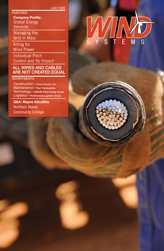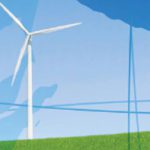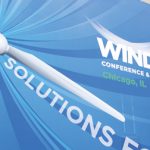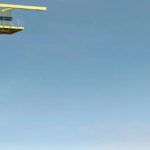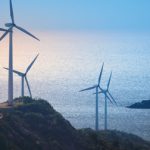Choosing the right wires and cables for wind farms may be one of the most important elements to consider in terms of longevity, reliability of service and cost of ownership for the system.
At the AWEA Windpower 2012 show in Atlanta, GA, many industry leaders lamented the fact that employing best practices in selecting equipment and materials are not always the reality.
Wire and cable manufacturers in particular say they are disappointed to see customers sacrificing projects by choosing lesser quality materials.
“Reliability and cost of ownership of all wind farm components should be the top priority in wind energy assets because the lifecycle cost of such a major investment is an important consideration,” said Jim Rosborough, North America Commercial Director, Dow Electrical &Telecommunications. “We see some developers choosing cheap and unreliable products that fail early and often when maintenance and replacement is not in the budget. This could have been avoided by using the right product from the beginning of the project.”
In the rush to cash in on wind energy, some developers trade low first costs for higher total cost of ownership over the life of the system. The lowest cost wind project is when you do it right from the beginning. Costly repairs to fix a project won’t be sustainable in the long term,” he said.
Potential failures and repairs can saddle owners, operators and ultimately the communities they serve with unexpected expenses, higher utility prices and premature equipment failure.
“Wire and cable components constitute a relatively small percentage of the total cost of the project – less than one percent. And the difference in cost between quality components and lower quality, lower price components can be less than 10 percent. Therefore it doesn’t make sense to endanger the reliability of a $500 million wind project by using off-quality materials,” said Ron Burchfield, director, Renewable Energy, Southwire Company. “The resulting cost of repairs from using off-quality materials is eventually passed to the owners and operators and ultimately the customers.”
Wire and cable suppliers and manufacturers see this as a problem with some of the developers that have only a short-term interest in a project before selling to a permanent owner. The realization of quick profits by using lower quality components will come at the expense of owners and users of the system.”
“Wind assets make money when they deliver energy to the grid. In other words, what comes out of the substation is what the wind farm gets paid for,” Burchfield said. “So all materials going into the system – from turbines to cable – need to be of a high standard from the beginning.”
Engineers say the rush to commission more wind farms has outstripped the usual development cycle of trial and error that results in mature technologies that define the equipment suited for the job. This may result in purchasing decisions based on lowest initial cost of ownership, not solutions that provide the best choice in terms of cost of ownership, network stability, higher maintenance costs and more downtime. Figure 1
Carol Godfrey, vice president of marketing and product development for Southwire’s Energy Division agrees. “If you deliver value with high performance assets and time, energy and engineering talent is considered and used properly, you’ll find longevity because of the pride and quality of workmanship throughout the system. Wire and cable is a key component of those systems.”
In a paper by the IEEE PES Wind Plant Collector System Design Working Group titled, Design and Application of Cables and Overhead Lines in Wind Power Plants, the authors provided a summary of the most important considerations for wind power plant collection systems. In their research, cable selection, cable properties, cable splicing and construction above or below ground were all considered. “Ease of installation and handling, as well as jacket material, insulation and rating, short circuit withstand ratings, and conductor material are all considered important in reliability and longevity of the wind power system.
“Making quality cable and using quality cable should be part of best practices for the wind industry. The industry currently lacks standards that are used in traditional power systems,” Burchfield says. “We’re confident in our reputation and our product because we’ve had cables, manufactured to meet or exceed power industry standards in the ground with major energy companies and our products are still doing the job.” Figure 2
Dow E&T also has a successful history with its products and Rosborough says Dow works with cable makers such as Southwire to deliver materials such as DOW ENDURANCE HFDC-4202 EC, an advanced performance tree-retardant cross-linked polyethylene (TR-XLPE) MV insulation to insure reliability.
“Dow E&T upgraded its medium voltage (MV) insulation to achieve a new level of performance for underground (UG) cable manufacturers, installers and utilities,” Rosborough said. “The HFDC-4202 EC provides easier installation, lower operating costs for the wind farm, enhanced reliability, longer life and optimized asset management.” Product Showcased
“Dow is excited to partner with Southwire because quality materials combined with quality cable manufacturing delivers the best outcome for customers,” Rosborough said. “Wind power producers must ensure reliability of the power connection for the duration of the wind farm lifecycle.”
Rosborough continued by saying that Dow has demonstrated that proper material selection is critical to the performance of cable in field applications by conducting rigid testing and surveys of utility cable engineers who identified several attributes they consider valuable for reliable performance.
Like Dow in the insulation of products, Southwire is the leading wire and cable manufacturer in North America, offering utility cable products, including overhead and underground transmission and distribution cable and other products for industrial applications. Southwire’s complete renewable energy solutions include wire and cable for turbines, towers and collection, overhead and underground transmission and substation wiring. Figure 3
“Wind is one of the fastest growing segments of our energy portfolio,” Burchfield said. “As a full-line cable supplier for this market, we’re excited to let our customers know how Southwire’s cables ensure reliable, cost-effective power throughout the life of renewable energy systems.”
Rosborough said unplanned cable repairs are costly in terms of maintenance and downtime is a profit killer that could be avoided by installing cables that exceed utility industry standards in UG cable for wind power applications. Produced Showcased
“TR-XLPE insulated MV cables made with DOW ENDURANCE products have been operating in-ground for years,” Rosborough said. “We know our products will last because they’ve already been tested in traditional utility applications. We have done studies with utilities to dig up cables to assess long-term performance. In one study, after 17 years in service, the insulation exceeded in providing electrical strength and long wear well above NA-ANSI / ICEA minimum requirements. These same cables, now 30 years in service, says a lot about the product; same thing with Southwire’s cables and wires. They have been in business 60 years in traditional utility applications and since the beginning with wind turbines in the U.S., and their products are still performing as expected.”
Rosborough said the insulation materials are produced at the company’s plants in North America and reduce dielectric losses to increase the amount of energy delivered, while eliminating failure and repair costs. The insulation results in clean and consistent performance, retention and magnitude of electrical strength efficiency. The jacketing’s physical characteristics resist moisture absorption, the conductor shield is fully bonded and the insulation shield is easy to strip.
He attributes the success of his company’s products to extensive testing and validation processes and a commitment to produce wire and cable products that exceed current power industry standards.
Burchfield agrees that being committed to developing the best products available is important to meet the unknown challenges of the renewable market, both on and offshore in a variety of demanding applications.
Southwire also offers a complete line of products for the wind market, including its TR-XLPE medium voltage cables, overhead CAMV cables, 2KV power cables, fiber-in-duct and grounding conductors, all used in the wind farm collection system.
Additionally, they produce the cables used within the wind turbine and tower, the cables used withstand the substation and a full line of both overhead and underground high voltage transmission cables.
As a single source providerwind turbine DLO, kV Cable, for transferring power in wind turbines in wet or dry areas. This cable resists oils, acids, alkalines, heat, flame and has abrasion resistance.
As a single-source provider for cables from generation to transmission, Burchfield says the company’s customizable solutions may help to improve costs, reliability and compliance throughout the energy chain.
For more information, call 770-832-4403 or visit www.southwire.com. Also call 1-800-441-4369 or go to www.dow.com/electric.



















